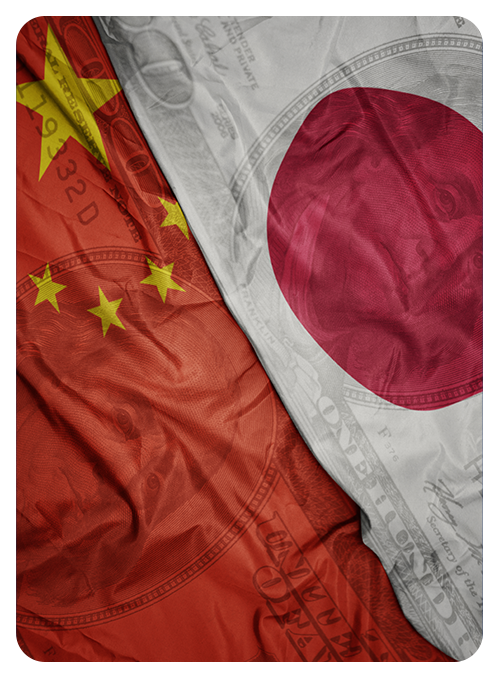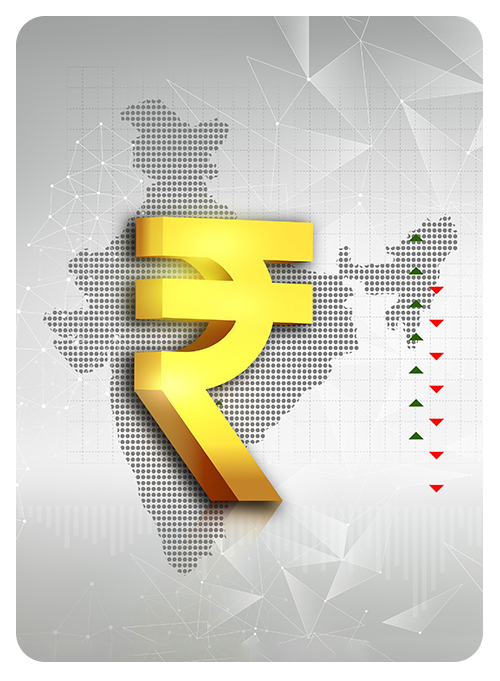Finsphere
Navigating Market Volatility:
As global uncertainty and policy shifts, investors must stay agile to capitalize on emerging opportunities in the market.

Dear Clients and Stakeholders,
Markets have been on the edge in recent weeks, reacting to weak corporate earnings and geopolitical uncertainty resulting in Nifty correcting by 10% from its all-time highs. However, the FY26 budget provided a timely boost to private consumption, helping stabilize sentiment. The present scenario provides long-term investors an excellent opportunity to pick quality stocks at attractive valuations.
The past month has marked a significant turning point for global markets, shaped by geopolitical transitions and economic recalibrations. Mr. Donald Trump’s inauguration as the 47th President of the United States was swiftly followed by whirlwind of changes as he looked to push through his promises of tax and spending cuts, trade tariffs, immigration controls and regulatory reforms. Early February saw the signing of three executive orders imposing tariffs on key trade partners. While eleventh hour discussion delayed tariffs on Canada and Mexico by a month, the additional 10% tariff on Chinese imports remains on course, setting the stage for an escalating trade conflict.
The US markets provided a buoyant response to Mr. Trump assuming office and strong corporate earnings. The S&P 500 climbed 2.7% in January, reaching 6,040.53, while the Nasdaq advanced 2.5% to 19,791.99. The Dow Jones Industrial Average posted a strong 4.7% gain, closing at 44,544.66, and broader markets reflected similar enthusiasm, with the Russell 2000 advancing 2.6% to 2,287.69.
The IMF reiterated its global growth forecast at 3.2% for 2024 with a projected 3.3% growth in both 2025 and 2026, though it cautioned about potential downside risks from geopolitical tensions and trade conflicts. The looming trade conflicts between US and China, Mexico, and Canada and the resulting inflationary risks, presents an evolving economic landscape with both challenges and opportunities. Investors must remain agile, adapting to both opportunities and risks presented by this evolving landscape.
United States
Strong economic growth amid tariff and inflation concerns.
The U.S. economy remained on solid footing, expanding at an annualized rate of 2.3% in fourth quarter of 2024 aided by strong consumer and government spending. Meanwhile, the Federal Reserve opted to keep benchmark interest rates unchanged at 4.25% - 4.50%, with Fed Chair Jerome Powell reiterating the need for a measured approach to rate cuts, citing persistent inflationary concerns and ongoing supply-side constraints.
Inflation remained a critical concern, with Personal Consumption Expenditure (PCE), the Fed’s preferred measure of inflation, rising 0.3% month-over-month. Factory gate prices also increased by 0.2%, indicating continued pipeline inflation. The labor market demonstrated strength, as non-farm payrolls rose by 256,000 in December, with significant job additions in healthcare, government, and retail trade. Unemployment edged lower to 4.1%, reinforcing the notion of a stable job market. Industrial production recorded its strongest gain since February, expanding by 0.9%, driven by a resurgence in manufacturing activity and the resolution of supply chain disruptions in the aviation sector. With inflationary pressures still in play, the Fed faces a delicate balancing act in sustaining economic growth while keeping inflation under control.


Eurozone and UK
Economic challenges and policy shifts.
The Eurozone remains mired in uncertainty as Germany, its largest economy, prepares for snap elections on February 23rd following Chancellor Olaf Scholz’s loss in a vote of no confidence. This political transition could reset Europe’s economic policy landscape, adding to existing economic challenges.
The annual inflation rate in the Euro Area accelerated for a third straight month to 2.4% in December of 2024, the highest rate since July. However, the European Central Bank’s updated inflation outlook and delay in wage increases, prompted it to lowered its key interest rates by 25 bps in January 2025, reducing the deposit facility rate to 2.75%, the main refinancing rate to 2.90%, and the marginal lending rate to 3.15%. Factory activity continued to be weak as November’s industrial production showed marginal month-over-month improvement of 0.2%, though it remains down 1.9% on an annual basis.
In the UK, inflation unexpectedly slowed to 2.5% in December from 2.6% in the previous month, prompting the Bank of England to cut interest rates by 25 basis points to 4.5%. However, policymakers have expressed caution about further rate cuts, given the risk of an inflation re-emerging amid global economic uncertainty.
Weak demand remains a concern, with retail sales declining 0.3% in December, while industrial production also contracted by 0.4% month-over-month, weighed down by weak manufacturing and mining output.
Euro area is navigating uncertainty surrounding the ongoing snap elections in Germany. Looking ahead while facing an uphill battle as weak demand, softening industrial activity weigh on economic momentum.
Asia
Evolved from ‘Emerging Market Basket’ to Country Specific Opportunity!
Asian markets have shown resilience, with Japan and China emerging as bright spots. Japan’s recovery has been steady, prompting the Bank of Japan to raise interest rates by 25 basis points to 0.5% its highest level since 2008. The decision reflects improving wage growth and sustained inflation, which jumped to 3.6% in December, its highest reading in nearly a year.
In China, economic activity showed signs of a turnaround, bolstered by targeted stimulus measures introduced in September 2024. The economy expanded by 5.4% year-over-year in the fourth quarter, exceeding market expectations and marking the fastest pace of growth in 18 months. Industrial production surged 6.2% year-over-year in December, driven by strong manufacturing performance and government support measures. However, China’s inflation rate remained subdued at just 0.1% in December, highlighting deflationary risks despite aggressive policy interventions.
Asia is now a country specific plays rather than a ‘Emerging market basket’ play. Markets have evolved over time to capability and product offerings play from cost arbitrage offerings.


India’s Economic Pulse:
Weak corporate earnings, private consumption boost
The FY26 Budget presented by the Indian Government has adopted a balanced approach, prioritizing domestic consumption while maintaining capital allocations for key sectors like defense and infrastructure. While the absence of a significant capex increase might have provided disappointment initially, it has been a step in the right direction towards a more prudent fiscal discipline. Direct tax relief provided to individual investors and RBI’s recent announcement of forex and open market measures to inject about Rs.1.5 lakh crores into the financial system are expected to aid consumption in India. Further, RBI’s recent reduction of repo rate by 25 bps to 6.25%, the first such reduction in 5 years, is expected to support economic activity and drive consumption-led growth. Meanwhile, inflation in India continued to ease to 5.22% in December 2024, as food inflation, which accounts for nearly half of the consumer basket, slowed down to 8.39% compared to 9.04% in November.
The Economic Survey 2024-25 pointed that India achieved H1FY25 growth of 6%, primarily driven by rural consumption while urban demand and capital expenditure slowed down. For the entire year, the GDP growth is forecasted to be 6.4% as government spending resumed in H2FY25. The forecasts for FY26 indicate a growth of 6.7% aided by policy changes oriented towards growth. Considering these factors, the recent correction in Nifty by close to 10% from its peak presents investors a unique opportunity to buy quality stocks offering long term value at reasonable valuations.
Conclusion
At Chola Securities, we remain committed to navigating these complexities with clarity and precision, ensuring that your investments are aligned with emerging opportunities and resilient to potential headwinds.
We sincerely thank you—our valued clients and investors—for your continued confidence and partnership. Together, we look forward to embracing the challenges and opportunities of the months ahead, ensuring sustained growth and success.
Warm Regards,
Mr. Senthilkumar Naidu
Chief Business Officer, CSec
